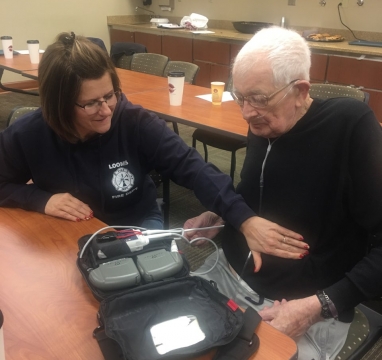Left Ventricular Assist Device (LVAD) was the topic of education for several area medical providers, area EMT’s, and the emergency services and cardiac rehab teams at Phelps Memorial Health Center.
LVAD is a battery-operated, mechanical pump-type device that is surgically implanted in the chest and helps maintain the pumping ability of a heart that can’t effectively work on its own. It is not an artificial heart; instead, it assists the heart in doing its job. An LVAD restores normal blood flow to a person whose heart has been weakened by heart disease.
Leah McClement, clinical consultant with Abbott, taught the education and stated, “There are a lot of patients that do not qualify for heart transplants and may never qualify for heart transplants.
She added, “We can put a heart pump in someone who isn’t a transplant candidate and help them live their best life for as long as they can.”
The “heart pump” population grows each year and this education specifically addressed the components and functions of the pump, how to assess the LVAD patients prior to arriving at the health center and best treatment options once there.
Attendees were able to have hand-on experience with vital signs, changing batteries and demonstrations of the device. Discussion was held on the differences between normal heart rhythms and a patient with an LVAD.
The pumps are palm-sized and have a cable that connects to leads outside the body. An impeller within the pump spins which results in continuous blood flow, which means LVAD patients don’t have a palpable pulse or measurable blood pressure. The external components include a controller and batteries, which power the system. In addition, patients carry identification and phone numbers to the LVAD team coordinator/implanting center who will guide first responders and medical providers in emergent situations.
John Ashley, who has had an LVAD for five years, was present at the education to show attendees exactly what the device looks like. He said, “I was happy to show everyone. It’s fairly rare around here so it’s good for everyone to learn and see what it looks and sounds like.”
“It’s crucial that our EMS providers and members of our team appropriately assess these patients,” said Liz Patterson, RN, charge nurse at Phelps Memorial Health Center.
She explained that if an LVAD patient becomes unconscious due to low blood sugar, that patient would not have a palpable pulse. Usually an emergency responder would give chest compressions to a patient without a pulse, but an LVAD patient doesn’t need chest compressions, only breathes. The implanted device (LVAD) is circulating the blood around the body continuously.
Photo: Cheryl Dunn, First Responder for Loomis Fire and Rescue, is shown visiting with John Ashley after an educational program at Phelps Memorial Health Center on left ventricular assist devices (LVAD). Mr. Ashley has had his LVAD for 5 ½ years.



